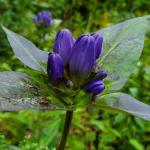UMass Extension's Landscape Message is an educational newsletter intended to inform and guide Massachusetts Green Industry professionals in the management of our collective landscape. Detailed reports from scouts and Extension specialists on growing conditions, pest activity, and cultural practices for the management of woody ornamentals, trees, and turf are regular features. The following issue has been updated to provide timely management information and the latest regional news and environmental data.
Registration has begun for our UMass Extension GREEN SCHOOL!
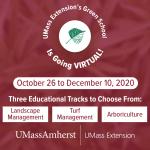 Green School is going VIRTUAL for 2020! Classes will be Oct. 26 - Dec. 10.
Green School is going VIRTUAL for 2020! Classes will be Oct. 26 - Dec. 10.
This comprehensive 12-day certificate short course for Green Industry professionals is taught by UMass Extension specialists, University of Massachusetts faculty, and guest presenters.
Three Specialty Tracks Are Offered:
* Landscape Management
* Turf Management
* Arboriculture - specifically geared toward professional arborists
Find the full schedule and registration info at http://ag.umass.edu/greenschool
For eligible employers in Massachusetts, the registration fee may be partially reimbursed (up to 50%) through the Massachusetts Workforce Training Fund Express Grant Program. Employers should submit an online application to the Express Grant program at least 4 weeks in advance of Green School's starting date. To find out if you qualify and to apply for benefits, go to http://workforcetrainingfund.org/apply/express-program/.
To read individual sections of the message, click on the section headings below to expand the content:
Scouting Information by Region
Environmental Data
The following data was collected on or about September 2, 2020. Total accumulated growing degree days (GDD) represent the heating units above a 50° F baseline temperature collected via our instruments for the 2020 calendar year. This information is intended for use as a guide for monitoring the developmental stages of pests in your location and planning management strategies accordingly.
|
MA Region/Location |
GDD |
Soil Temp |
Precipitation
|
Time/Date of Readings |
||
|
2-Week Gain |
2020 Total |
Sun |
Shade |
|||
|
CAPE |
294 |
2199 |
70 |
67 |
0.27 |
12:00 PM 9/2 |
|
SOUTHEAST |
286 |
2376 |
70 |
67 |
0.80 |
3:30 PM 9/2 |
|
NORTH SHORE |
262.5 |
2288.5 |
66 |
62 |
0.81 |
9:30 AM 9/2 |
|
EAST |
295.5 |
2512.5 |
71 |
68 |
2.31 |
5:00 PM 9/2 |
|
METRO |
294 |
2301 |
64 |
61 |
1.84 |
6:45 AM 9/2 |
|
CENTRAL |
254.5 |
2321 |
59 |
58 |
1.60 |
7:00 AM 9/2 |
|
PIONEER VALLEY |
252.5 |
2308.5 |
69 |
64 |
1.02 |
5:00 PM 9/2 |
|
BERKSHIRES |
228 |
2086.5 |
69 |
63 |
1.19 |
10:00 AM 9/2 |
|
AVERAGE |
271 |
2299 |
67 |
64 |
1.34 |
_ |
|
n/a = information not available |
||||||
Updated as of 9/1, this map shows the majority of MA in either a "Moderate Drought" or a "Severe Drought" category: https://droughtmonitor.unl.edu/CurrentMap/StateDroughtMonitor.aspx?MA
To track water use restrictions/bans by town, regularly check the MassDEP map: https://www.mass.gov/doc/water-use-restrictions-map/download
Phenology
| Indicator Plants - Stages of Flowering (BEGIN, BEGIN/FULL, FULL, FULL/END, END) | ||||||||
|---|---|---|---|---|---|---|---|---|
|
PLANT |
CAPE |
SE |
NS |
EAST |
METRO |
CENT |
PV |
BERK |
|
Clematis paniculata (sweet autumn Clematis) |
Begin |
* |
Begin/Full |
* |
Begin |
* |
Begin/Full |
Begin |
|
Polygonum cuspidatum (Japanese knotweed) |
Full |
Full |
* |
Begin |
* |
* |
Full |
Begin |
|
Hydrangea paniculata (panicle Hydrangea) |
Full/End |
End |
Full/End |
Full/End |
Full/End |
Full/End |
Full |
Full |
|
Hibiscus syriacus (rose-of-Sharon) |
Full/End |
End |
Full/End |
Full/End |
Full/End |
Full/End |
Full/End |
Full/End |
|
Buddleia davidii (butterfly bush) |
Full/End |
Full/End |
Full/End |
Full/End |
Full/End |
Full/End |
Full/End |
Full/End |
|
Clethra alnifolia (summersweet Clethra) |
End |
Full/End |
End |
End |
End |
End |
End |
End |
|
Lythrum salicaria (purple loosestrife) |
Full/End |
End |
End |
End |
End |
End |
End |
Full/End |
| * = no activity to report/information not available | ||||||||
Regional Notes
Cape Cod Region (Barnstable)
General Conditions: The average temperature during the two-week period was 70˚F with a high of 91˚F on August 25 and a low of 51˚F on August 31. Over the past week or so it has felt very much like late summer with several nights reaching into the 50s. Days are noticeably shorter. During the period there were several precipitation events, however amounts were negligible with just over a quarter inch in all. The total precipitation recorded in Barnstable for June, July and August combined was 3.11 inches. Top soil and subsoil moisture are dry.
Pests/Problems: The primary issue seen in the landscape is plant stress because of low soil moisture due to a lack of precipitation. Wilting, scorch, premature defoliation, and plant failure are seen in unirrigated landscapes. Dry conditions are hampering the ability to renovate damaged lawns. Insects or insect damage observed during the period include Lecanium scale on numerous hosts (nymphs can be observed on leaves), pine tip moth damage to pitch pine and mugo pine, hemlock wooly adelgid and hemlock elongate scale on hemlock, black turpentine beetle damage to pitch pine, white pine weevil damage to white pine, lacebugs on azalea, Andromeda, and sycamore, dogwood sawfly larvae on pagoda dogwood, chilli thrips damage on bigleaf Hydrangea, Hibiscus sawfly on Hibiscus, two spotted spidermite on butterfly bush and sunflower moth damage to Echinacea. Disease symptoms or signs observed during the period include powdery mildew on the usual suspects, cedar apple rust on apple, Cercospora leaf spot on bigleaf and oak leaf Hydrangea, Phytophthora root rot on lavender and aster yellows on goldenrod. Crabgrass is beginning to flower.
Southeast Region (Dighton)
General Conditions: We've moved into late summer with cool nights and more moderate daytime temperatures. However, drought still stalks the landscape despite some passing showers and thunderstorms. Unirrigated lawns are generally reduced to straw and weeds. Spotted spurge, yellow wood sorrel and crabgrass are all advancing. Chickweed is already germinating where it has moisture. Some day-length sensitive summer annuals have stopped blooming. Monarch caterpillars are finger size. Mud daubers, carpenter bees, yellow swallowtail butterflies, hummingbirds and others frequent the few remaining blooms. Japanese knotweed is in full bloom. Among the plants presently flowering I've noticed: Phlox paniculata (garden Phlox), Rudbeckia spp. (black-eyed-Susan), Vitex agnus-castus (chaste tree), Hydrangea paniculata, Hosta spp. (plantain lily), Sedum 'Autumn Joy', Rosa 'Knockout', Salvia yangii (Russian sage), Rhus typhina (staghorn sumac), Albizia julibrissin (mimosa), Campus radicans (trumpet vine), Reynoutria japonica (Japanese knotweed), Solidago spp. (goldenrod) and Ambrosia artemisiifolia (annual ragweed).
Pests/Problems: Both EEE and West Nile Virus infections have been reported. We are all preoccupied with PPE for virus prevention lately, but don't forget to cover up. Use repellent and avoid hours when mosquitoes are active. Mildew is becoming a problem. With high humidity and temperatures in the 60s there is a potential for Botrytis bud rot. Now is the time to harvest, reseed, divide and replant.
North Shore (Beverly)
General Conditions: During this August 20 - September 2 reporting period, scattered thunderstorms were reported in the region for a few days, bringing some much needed rainfall. Approximately 0.81 inches of rainfall were received during this period. The prolonged period of hot, humid and dry conditions seems to be over. The rain showers ushered in cooler temperatures throughout the region. The average daily temperature during this two-week period was 68˚F, with the maximum temperature of 89℉ recorded on August 21 and the minimum temperature of 51℉ recorded on August 31. Because of the rain showers during this period, the turf that had gone dormant and brown during the hot dry weather has started to green-up. Woody plants seen in bloom include: silk tree or mimosa (Albizia julibrissin), panicle Hydrangea (Hydrangea paniculata), butterfly bush (Buddleia davidii), rose-of-Sharon (Hibiscus syriacus),chaste tree (Vitex agnus-castus), Daphne (Daphne spp.) and Hibiscus ‘Fireball’. Herbaceous plants seen in bloom include: garden Phlox (Phlox paniculata), Japanese Anemone (Anemone x hybrida), hardy Begonia (Begonia grandis), hardy Geranium (Geranium spp.), milkweed (Asclepias spp.), sweet autumn Clematis (Clematis paniculata) and summer annual plants. A flush of yellow in some meadows and gardens, is thanks to goldenrod spp. in full bloom; a misunderstood plant which provides essential late-season food for our pollinators and cannot cause human allergies because the pollen is too heavy to be air borne.
Pests/Problems: Powdery mildew continued to be observed on lilac and garden Phlox, and Magnolia or tuliptree scales were observed on Magnolia. Crabgrass and yellow nutsedge are thriving on some lawns. Ticks and mosquitoes are less active but there is a risk of being bitten. Always remember to use repellents when outdoors especially in the woods during dawn and dusk.
East Region (Boston)
General Conditions: Over the last two weeks of August, we experienced several days in the 90’s with high humidity, mixed with some early fall-like mornings in the 50’s. Several rain events occurred during this reporting period totaling 2.31 inches. The only significant event was on August 23 when we received a small amount of hail, thunderstorms and 1.8 inches of much needed precipitation. The overall landscape remains dry. Many resilient plants are blooming; Hibiscus syriacus (rose-of-Sharon), Hydrangea paniculata (panicle Hydrangea) and late summer perennials continue to flower. Cicadas, katydids and crickets continue to perform a nightly chorus.
Pests/Problems: Dry soil is the primary concern moving into September. Despite the recent precipitation and somewhat cooler temperatures, the landscape is suffering the effects of the hot and dry conditions of the previous months. Overall plant stress is evident throughout the landscape. Leaf disease is prevalent on trees, shrubs and in mixed borders. Premature leafdrop is widespread with minimal early fall color. American pokeweed (Phytolacca americana) continues to flower and fruit along roadsides. The ubiquitous invasive Polygonum cuspidatum (Japanese knotweed) has begun flowering.
Metro West (Acton)
General Conditions: The summer season is winding down. Day length is shorter - currently at 13:05 hours with sunrise at 6:14 and sunset at 7:19 - and is getting noticeably shorter every day. Plants are heavy with fruit, seed, berries, and nuts while temperatures are cooling down. For August, the historical monthly average precipitation is 3.72” but only a total of 1.84” of rain was recorded for the month. The historical monthly average precipitation for September is 3.77” and as of the 2nd, there was zero precipitation recorded. Observed in some stage of bloom these past couple of weeks were the following woody plants: Buddleia spp. (butterfly-bush), Clethra alnifolia (summersweet), Heptacodium miconioides (seven-son flower), Hibiscus syriacus (rose-of-Sharon), H. paniculata (panicle Hydrangea and its many cultivars including 'Tardiva'), Potentilla fruiticosa (Potentilla), Rhus typhina (staghorn sumac), Rosa 'Knockout' (Knockout family of roses), and R. spp. (rose). A woody vine in bloom is Clematis paniculata (sweet autumn Clematis). Perennials seen in some stage of bloom these past two weeks were the following: Achillea millefolium (yarrow), Aster spp. (New England Aster, New York Aster, smoother Aster, white wood Aster), Astilbe spp. (false spirea), Boltonia asteroides (Bolton’s Aster), Coreopsis spp. (tickseed), C. verticillata (threadleaf Coreopsis), Daucus carota (Queen Anne's lace), Echinacea purpurea (coneflower) and its many cultivars, Eutrochium purpureum (Joe pye weed), Geranium sanguineum (cranesbill Geranium), Gaillardia aristata (great blanket flower), Hemerocallis spp. (daylily), Hosta spp. (plantain lily), Kirengeshoma palmata (yellow wax bells), Leucanthemum spp. (shasta daisy), Lilium spp. (lily), Patrinia gibbosa (Patrinia), Perovskia atriplicifolia (Russian sage), Phlox carolina (Carolina Phlox), P. paniculata (garden Phlox), Platycodon grandiflorus (balloon flower), Rudbeckia fulgida var. sullivantii 'Goldsturm' (Goldsturm black-eyed Susan), Sedum ‘Autumn Joy’, S. ‘Rosy Glow’ (stonecrops), Senna marilandica (wild Senna), and Solidago spp. (goldenrod).
Pests/Problems: Despite the recent slow and steady rain event this past Saturday, August 29th, this area remains in a moderate drought according to the US Drought Monitor. https://droughtmonitor.unl.edu/CurrentMap/StateDroughtMonitor.aspx?MA
Central Region (Boylston)
General Conditions: A very pleasant string of weather to close out the month of August. This reporting period featured high temperatures consistently below 80F and minimum temperatures in the 40’s for the first time since mid-June. Wonderful sleeping weather and welcome relief after weeks of hot, sticky summer conditions. Solidago spp. (goldenrod) are in bloom across the region, carpeting minimally managed areas in golden yellow blossoms. In addition to goldenrod, there is much in bloom during this late summer season. Of note, Actaea rubifolia (American bugbane), Actaea simplex (bugbane), Clethra barbinervis (Japanese clethra), Eriocapitella japonica (formerly Anemone hupehensis var. japonica, Japanese anemone), Gentiana clausa (closed gentian), Heptacodium miconioides (seven sons flower), and Hibiscus syriacus (rose of Sharon).
Pests/Problems: Powdery mildew was observed on phlox, lilac, peony, and other landscape plants. Fire blight was observed on spiraea and crabapple. Beech scale on Fagus grandifolia (American beech) is obvious at this time of year. The scale insects appear small and almost fuzzy along infected branches. The scale damages beech bark, which in turn invites two species of fungus that cause beech bark disease (Neonectria ditissima and N. faginata). Drought continues to be a major problem. The southern portion of the central region is in “Severe Drought” according to the U.S. Drought Monitor. https://droughtmonitor.unl.edu/CurrentMap/StateDroughtMonitor.aspx?MA The majority of the commonwealth is currently experiencing moderate drought conditions; however, recent weather patterns give hope for an end to this dry spell. We finished out the month of August with the wettest period since the first week of May and hope for the wet weather to continue as we move into fall.
Pioneer Valley Region (Easthampton)
General Conditions: Autumn has unofficially arrived as we begin the month of September in the Pioneer Valley. After a hot and dry summer, temperatures cooled dramatically during the last week of August, ushering in a stretch of beautiful weather for gardening, fall planting and turfgrass establishment. On what may have been our last, truly hot days, the mercury peaked at 95°F and 93°F on 8/23 and 8/24, respectively. From 8/26 onward, highs ranged from 69–84°F while lows spanned 47–62°F. The low of 47°F was recorded during the morning of 8/31 and it felt downright cold after our acclimation to the torrid heat of the past few months. Despite the late August cool-down, August temperatures were still above-average throughout southern New England. Overall, the majority of northeast weather stations recorded one of their hottest summers in history, highlighted by a July that was the hottest month ever recorded for many locations. The NRCC summarizes the blazing hot summer of 2020 here. Rainfall was once again highly scattered in the region. Widespread showers and thunderstorms occurred on 8/27, with totals ranging from 0.3″ to 0.8″ in the tri-counties. The remnants of Hurricane Laura then blew through on Saturday, 8/29. Franklin County received some significant rain (>1.2″ in Greenfield) while most of Hampshire and Hampden were once again left out of the precipitation party (0.25″ in Easthampton and 0.5″ in Springfield). Eastern Hampshire County has fared well, with 5.3″ of rainfall recorded in August at the UMass Cold Springs orchard. Additional rain occurred at the time of writing on 9/2, although accumulations will hardly meet the need. At this point, it would take consecutive days of slow, soaking rainfall to satisfy the parched soils in the valley. New growth is appearing on certain landscape conifers, such as yew, false cypress, and juniper. The hot and dry summer has shown the value of incorporating conifers into your garden. Once established, many require only limited supplemental water (if any) and can thrive under intense heat. Panicle Hydrangea is also showing why it’s one of the most popular landscape plants.
Pests/Problems: As in previous reports, the lack of rain continues to be our biggest problem. Southern and eastern Hampden County is categorized as D2 (severe drought) while the rest of the valley remains in D1 (moderate drought) classification, based on the U.S. Drought Monitor. https://droughtmonitor.unl.edu/CurrentMap/StateDroughtMonitor.aspx?MA Continue to provide a soaking irrigation of the root zone for recent transplants and established plants weakened by disease/insect problems. Early fall color is starting to appear on drought-stressed red and sugar maples. Reddening of upper canopy leaves continues to develop on Viburnums. Landscape apples and crabapples have shed the majority of their foliage due to apple scab and drought stress. Mushrooms of wood-rotting and mycorrhizal fungi are not abundant due to the dry soils. Some late season foliar diseases may be gaining steam right now, but with annual growth complete, or nearly, for the season, these diseases are of little consequence. Rodent feeding continues to be an issue. Don’t let voles get established in your gardens before winter. Under the cover of snow, they can do considerable damage to small diameter trees and shrubs by chewing bark at the base.
Berkshire Region (Great Barrington)
General Conditions: The rain this week was welcomed, especially since this is a great time to be planting herbaceous perennials and woody plants, except for needled evergreens which are best left to spring planting. Before the rain, the rainfall deficit, as recorded at Pittsfield Airport, was 7.19 inches below normal, year to date and soils have been very dry. September is a critical month for landscape plants. Past studies have shown that winter survival of trees and shrubs is highly dependent on the water they take up in September. So, be prepared to water these plants if rainfall is deficient. This is especially important for newly planted trees and shrubs. Air temperatures since this past weekend have returned to normal for this time of year with day time readings in the low to mid 70s. That was quite a drop from the 88˚F readings on August 23 and 24. Also, night time temperatures have dropped recently. Lows of 49˚F and 45˚ F were recorded for West Stockbridge on the mornings of August 30 and 31, respectively.
Pests/Problems: The prolonged drought has resulted in brown patches on lawns where mowing height was too low. Some leaf scorch has been noted on some deciduous trees but is not wide spread. Needled evergreens, primarily white pine, growing in poor coarse soils have been showing needle browning through much of the summer. Disease problems are much the same as they have been through the summer, i.e. black spot on roses and apple scab on crabapples, and many of these plants are now showing considerable defoliation. Verticillium wilt has taken a toll on at least one Cotinus observed this year and that plant has now been removed. Dark staining of the vascular tissue, a symptom of Verticillium was evident in the plant stems when the plant was cut down. Plant pest activity has slowed considerably. Some mite activity on dwarf spruce continues. Maybe the most obvious issue now is the increase in damage to young trees, shrubs, and herbaceous perennials from deer. Plants in managed landscapes at this time of year are always a bit more succulent than those in the natural landscape.
Regional Scouting Credits
- CAPE COD REGION - Russell Norton, Horticulture and Agriculture Educator with Cape Cod Cooperative Extension, reporting from Barnstable.
- SOUTHEAST REGION - Brian McMahon, Arborist, reporting from the Dighton area.
- NORTH SHORE REGION - Geoffrey Njue, Green Industry Specialist, UMass Extension, reporting from the Long Hill Reservation, Beverly.
- EAST REGION - Kit Ganshaw & Sue Pfeiffer, Horticulturists reporting from the Boston area.
- METRO WEST REGION – Julie Coop, Forester, Massachusetts Department of Conservation & Recreation, reporting from Acton.
- CENTRAL REGION - Mark Richardson, Director of Horticulture reporting from Tower Hill Botanic Garden, Boylston.
- PIONEER VALLEY REGION - Nick Brazee, Plant Pathologist, UMass Extension Plant Diagnostic Lab, temporarily reporting from Easthampton.
- BERKSHIRE REGION - Ron Kujawski, Horticultural Consultant, reporting from Great Barrington.
Woody Ornamentals
Diseases
Recent pests and pathogens of interest seen in the UMass Extension Plant Diagnostic Lab https://ag.umass.edu/services/plant-diagnostics-laboratory:
Verticillium wilt, caused by Verticillium dahliae, of Japanese maple (Acer palmatum ‘Bloodgood’) and smoketree (Cotinus coggygria). The Japanese maple is approximately 25-years-old and has been present at the site for many years. It resides in droughty, compacted soils with plentiful sunlight within a residential yard. Last year, branch flagging was observed and has intensified this year. Leaves were brown and shriveled. The smoketree is roughly 10-years-old and resides in full sun with no supplemental irrigation. In 2018, the tree did not leaf out in the spring and was cut back hard in an attempt to restore it. In 2019, the plant seemed revived, according to the homeowner, and did quite well. However, this year the plant began showing symptoms of wilt in early July. Verticillium is a soilborne pathogen that invades through the roots and becomes systemic within the tree or shrub through the vascular tissue. Acer and Cotinus are two of the most common hosts in landscape settings.
Alternaria leaf spot (Alternaria sp.), Phomopsis stem cankering (Phomopsis sp.) and an infestation of the oystershell scale (Lepidosaphes ulmi) on California privet (Ligustrum ovalifolium). Plant is 10-years-old and been present on the site for five years. It’s growing in a mulched bed with drip irrigation and partial sun. Zonate leaf spots and blotches were observed this year, but were not present in prior years. An Alternaria species is responsible for the leaf spots, which at times, can result in leaf shedding and contribute to decline. California privet appears especially susceptible to infection. The oystershell scale infestation was minor to moderate in severity and very well camouflaged. This common landscape pest has a broad host range and its feeding wounds likely served as entry points for the cankering pathogen Phomopsis.
Wilting and dieback of Slender Silhouette sweetgum (Liquidambar styraciflua ‘Slender Silhouette’) caused by drought stress and foliar anthracnose (Colletotrichum). Several mature trees, approximately 4” in diameter, were planted in a tight row in May of 2019. They reside in a courtyard adjacent to a brick wall with a variety of other shrubs and perennials. In early August, wilting and leaf dieback was observed, which did not appear last year. The trees are provided with drip irrigation by an automatic system, but upon inspection the soils were quite dry. It was determined the irrigation system malfunctioned and turned off. The submitted sample included blackened leaves that were harboring the anthracnose pathogen Colletotrichum. In some cases, fastigiate trees, such as this cultivar, can be more susceptible to foliar diseases due to the compact, dense canopy.
Decline of white fir (Abies concolor) due to transplant shock and Rhizosphaera needle cast (Rhizosphaera pini). Tree is approximately 10-years-old and was transplanted in September of 2019. In late July, needle browning developed in the lower canopy and was spreading into the upper canopy. Another white fir transplanted at the same time did not survive the winter. Trees were planted in a meadow with full sun and it’s not clear if they’ve received supplemental water. White fir is an excellent landscape tree, especially in comparison to blue spruce, but can be difficult to transplant when larger trees are utilized.
Infestation of the elongate hemlock scale (Fiorinia externa) on eastern hemlock (Tsuga canadensis). Row of mature hemlocks, approximately 70-years-old, in front of a residential home. Current homeowner has been caring for the trees for 30 years. The submitted branches were harboring an extensive infestation of the elongate hemlock scale. But interestingly, some shoots with a significant population of scale showed no symptoms and had robust growth this year. Other shoots exhibited typical symptoms (mottled yellowing on the needle surface and premature needle shedding). The trees are provided with supplemental water and the hemlock woolly adelgid has been treated in the past with horticultural oil. However, the oil clearly was not effective in managing the scale.
Shoot tip dieback, caused by Phomopsis, on a dwarf Serbian spruce (Picea omorika). This mature tree is growing in full sun on the edge of a wall with drip irrigation. However, it’s unclear how often the system operates. Throughout the canopy, the new growth is blighted and curled. Phomopsis is a common pathogen on declining spruce, especially blue spruce, attacking weakened and stressed trees. Spider mites and needle blight pathogen (e.g. Rhizosphaera) were not located from the sample. Serbian spruce have needles that better resemble those of a true fir. Specifically, the needles are flattened with rounded tips and have two, wide rows of stomata on the underside. Spruce needles, however, are attached to the shoot by a short, woody “peg”, making them readily distinguishable from true firs.
Stem cankering and dieback of Rhododendron caused by Botryosphaeria. Small plant, transplanted in May, into a shade garden beneath a mature tree with no supplemental irrigation. In early July, the plant began to wilt and become chlorotic. No foliar blight symptoms were present on the submitted material, but clear evidence of stem cankering was found. Botryosphaeria s.l. species are common pathogens on stressed Rhododendrons in the landscape.
Report by Nick Brazee, Plant Pathologist, UMass Extension Plant Diagnostic Lab, UMass Amherst.
Insects
Did you miss the live broadcasts of UMass Extension’s Invasive Insect Webinar Series? No problem! View the archived recordings of all seven webinars here:https://ag.umass.edu/landscape/education-events/invasive-insect-webinars
Parasitized Tobacco Hornworm:
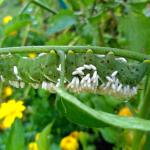
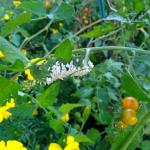 Since the last Landscape Message, a report was sent to me by my dear mother-in-law. “What in the world is this that I found in my garden!!!” was the text I received along with these photos. Her horror and disgust were my delight and excitement! She had found and photographed a parasitized tobacco hornworm (Manduca sexta) on her backyard tomatoes. The tobacco hornworm, photographed on 8/25/2020 in Berkshire County, MA was bursting with the pupae of Cotesia congregata, a type of braconid wasp (tiny parasitoid wasps). Cotesia congregata is a gregarious endoparasitoid, meaning that the female wasp lays multiple eggs inside the host, which then develop into immature wasps that feed on the insides of the caterpillar. The adult female wasp can lay up to approximately 65 eggs inside a single host, which quickly hatch into pale yellow-white grub-like larvae that are able to move freely inside the caterpillar as they feed. A single caterpillar can be host to as many as 300 of these larvae, if multiple adult female wasps lay their eggs in the same individual. Eventually, the larvae erupt from the cuticle of the caterpillar, and can be seen emerging from their host in order to spin a white cocoon tethered to the outside of the caterpillar. It is in these cocoons that the immature wasps pupate. Cocoons may eventually drop to the soil, where they can overwinter. Adult wasps will emerge the next season and seek out suitable host caterpillars. Another really cool aspect about this system is that at the time a female wasp lays her eggs inside the tobacco hornworm, she also injects venom and a symbiotic virus (polydnavirus) into the host. The virus prevents the hornworm’s immune system from attacking and killing the wasp’s eggs. While the tobacco hornworm is a pest of tomato and tobacco (not of trees or shrubs), this was too cool not to include in the Landscape Message!
Since the last Landscape Message, a report was sent to me by my dear mother-in-law. “What in the world is this that I found in my garden!!!” was the text I received along with these photos. Her horror and disgust were my delight and excitement! She had found and photographed a parasitized tobacco hornworm (Manduca sexta) on her backyard tomatoes. The tobacco hornworm, photographed on 8/25/2020 in Berkshire County, MA was bursting with the pupae of Cotesia congregata, a type of braconid wasp (tiny parasitoid wasps). Cotesia congregata is a gregarious endoparasitoid, meaning that the female wasp lays multiple eggs inside the host, which then develop into immature wasps that feed on the insides of the caterpillar. The adult female wasp can lay up to approximately 65 eggs inside a single host, which quickly hatch into pale yellow-white grub-like larvae that are able to move freely inside the caterpillar as they feed. A single caterpillar can be host to as many as 300 of these larvae, if multiple adult female wasps lay their eggs in the same individual. Eventually, the larvae erupt from the cuticle of the caterpillar, and can be seen emerging from their host in order to spin a white cocoon tethered to the outside of the caterpillar. It is in these cocoons that the immature wasps pupate. Cocoons may eventually drop to the soil, where they can overwinter. Adult wasps will emerge the next season and seek out suitable host caterpillars. Another really cool aspect about this system is that at the time a female wasp lays her eggs inside the tobacco hornworm, she also injects venom and a symbiotic virus (polydnavirus) into the host. The virus prevents the hornworm’s immune system from attacking and killing the wasp’s eggs. While the tobacco hornworm is a pest of tomato and tobacco (not of trees or shrubs), this was too cool not to include in the Landscape Message!
Lastly, you may be wondering – how do you tell apart a tobacco hornworm (Manduca sexta) from the tomato hornworm (Manduca quinquemaculata)? And why isn’t this caterpillar the tomato hornworm since it was found feeding on tomatoes? Well, both of these insects feed on both tomato and tobacco. The tobacco hornworm has black margins along the white stripes on the sides of its body, as well as a red horn. While the black margins are difficult to see in these photos, the red horn can be clearly seen. The tomato hornworm, on the other hand, has green margins along the white stripes on the sides of its body, and a blue horn.
Insects and Other Arthropods of Public Health Concern:
- Mosquitoes: On July 3, 2020 the Massachusetts Department of Public Health announced that the eastern equine encephalitis (EEE) virus had been detected in mosquitoes in Massachusetts for the first time this year: https://www.mass.gov/news/state-public-health-officials-announce-seasons-first-eee-positive-mosquito-sample-0 . For more information about the first 2020 EEE detection and ways to protect yourself, visit the link above.
For current information, including searchable risk maps for both EEE and WNV in Massachusetts, visit:https://www.mass.gov/info-details/massachusetts-arbovirus-update
According to the Massachusetts Bureau of Infectious Disease and Laboratory Science and the Department of Public Health, there are at least 51 different species of mosquito found in Massachusetts. Mosquitoes belong to the Order Diptera (true flies) and the Family Culicidae (mosquitoes). As such, they undergo complete metamorphosis, and possess four major life stages: egg, larva, pupa, and adult. Adult mosquitoes are the only stage that flies and many female mosquitoes only live for 2 weeks (although the life cycle and timing will depend upon the species). Only female mosquitoes bite to take a blood meal, and this is so they can make eggs. Mosquitoes need water to lay their eggs in, so they are often found in wet or damp locations and around plants. Different species prefer different habitats. It is possible to be bitten by a mosquito at any time of the day, and again timing depends upon the species. Many are particularly active from just before dusk, through the night, and until dawn. Mosquito bites are not only itchy and annoying, but they can be associated with greater health risks. Certain mosquitoes vector pathogens that cause diseases such as West Nile virus (WNV) and eastern equine encephalitis (EEE).
For more information about mosquitoes in Massachusetts, visit: https://www.mass.gov/service-details/mosquitoes-in-massachusetts
There are ways to protect yourself against mosquitoes, including wearing long-sleeved shirts and long pants, keeping mosquitoes outside by using tight-fitting window and door screens, and using insect repellents as directed. Products containing the active ingredients DEET, permethrin, IR3535, picaridin, and oil of lemon eucalyptus provide protection against mosquitoes.
For more information about mosquito repellents, visit: https://www.mass.gov/service-details/mosquito-repellents and https://www.cdc.gov/features/stopmosquitoes .
- Deer Tick/Blacklegged Tick: Check out the archived FREE TickTalk with TickReport webinars available here:https://ag.umass.edu/landscape/education-events/ticktalk-with-tickreport-webinars . Previous webinars including information about deer ticks and associated diseases, ticks and personal protection, and updates from the Laboratory of Medical Zoology are archived at the link above.
The next live webinar will be held on September 9, 2020: Biology of Ticks and Tick-Borne Diseases- Speaker: Dr. Daniel Sonenshine, Professor Emeritus, Old Dominion University; Laboratory of Malaria and Vector Research, National Institute of Allergy and Infectious Disease (NIH)
Dr. Rich will host Dr. Daniel Sonenshine, preeminent tick biologist who quite literally wrote the book on ticks (Biology of Ticks in two volumes, co-authored with Dr. R. Michael Roe). Dr. Sonenshine’s research interest in ticks precedes the discovery of Lyme disease in North America and he is thus uniquely qualified to provide a historical context for this public health challenge. To register for the next TickTalk, visit:https://ag.umass.edu/landscape/education-events/ticktalk-with-tickreport-webinars
Ixodes scapularis nymphs (immatures) are active, and may be encountered at this time, through August. Nymphs will have already taken a blood meal, and therefore can be infected with disease causing pathogens. It is important to protect yourself against ticks and be especially vigilant for tiny, difficult to see nymphs. For images of all deer tick life stages, along with an outline of the diseases they carry, visit: http://www.tickencounter.org/tick_identification/deer_tick .
Anyone working in the yard and garden should be aware that there is the potential to encounter deer ticks. The deer tick or blacklegged tick can transmit Lyme disease, human babesiosis, human anaplasmosis, and other diseases. Preventative activities, such as daily tick checks, wearing appropriate clothing, and permethrin treatments for clothing (according to label instructions) can aid in reducing the risk that a tick will become attached to your body. If a tick cannot attach and feed, it will not transmit disease. For more information about personal protective measures, visit: http://www.tickencounter.org/prevention/protect_yourself .
Have you just removed an attached tick from yourself or a loved one with a pair of tweezers? If so, consider sending the tick to the UMass Laboratory of Medical Zoology to be tested for disease causing pathogens. To submit a tick to be tested, visit: https://www.tickreport.com/ and click on the blue “Order a TickReport” button. Results are typically available within 3 business days, or less. By the time you make an appointment with your physician following the tick attachment, you may have the results back from TickReport to bring to your physician to aid in a conversation about risk.
The UMass Laboratory of Medical Zoology does not give medical advice, nor are the results of their tests diagnostic of human disease. Transmission of a pathogen from the tick to you is dependent upon how long the tick had been feeding, and each pathogen has its own transmission time. TickReport is an excellent measure of exposure risk for the tick (or ticks) that you send in to be tested. Feel free to print out and share your TickReport with your healthcare provider.
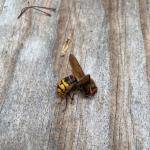
 Wasps/Hornets: Many wasps are predators of other arthropods, including pest insects such as certain caterpillars that feed on trees and shrubs. Adult wasps hunt prey and bring it back to their nest where young are being reared, as food for the immature wasps. A common such example are the paper wasps (Polistes spp.) who rear their young on chewed up insects. They may be seen searching plants for caterpillars and other soft-bodied larvae to feed their young. Paper wasps can sting, and will defend their nests, which are open-celled paper nests that are not covered with a papery “envelope”. These open-celled nests may be seen hanging from eaves or other outdoor building structures. Aerial yellow jackets and hornets create large aerial nests that are covered with a papery shell or “envelope”. Common yellow jacket species include those in the genus Vespula. Dolichovespula maculata is commonly known as the baldfaced hornet, although it is not a true hornet. The European hornet (Vespa crabro) is three times the size of a yellow jacket and may be confused for the Asian giant hornet (Vespa mandarinia). The European hornet is known to Massachusetts, but the Asian giant hornet is not. If you are concerned that you have found or photographed an Asian giant hornet, please report it here: https://massnrc.org/pests/report.aspx . A helpful ID tool, although developed for Texas by the USDA, depicts common look-a-like species that we also have in MA that can be confused for the Asian giant hornet and is found here: https://agrilife.org/lubbock/files/2020/05/Asian_Giant_Hornet_Look-alikes_101_Xanthe_Shirley.pdf .
Wasps/Hornets: Many wasps are predators of other arthropods, including pest insects such as certain caterpillars that feed on trees and shrubs. Adult wasps hunt prey and bring it back to their nest where young are being reared, as food for the immature wasps. A common such example are the paper wasps (Polistes spp.) who rear their young on chewed up insects. They may be seen searching plants for caterpillars and other soft-bodied larvae to feed their young. Paper wasps can sting, and will defend their nests, which are open-celled paper nests that are not covered with a papery “envelope”. These open-celled nests may be seen hanging from eaves or other outdoor building structures. Aerial yellow jackets and hornets create large aerial nests that are covered with a papery shell or “envelope”. Common yellow jacket species include those in the genus Vespula. Dolichovespula maculata is commonly known as the baldfaced hornet, although it is not a true hornet. The European hornet (Vespa crabro) is three times the size of a yellow jacket and may be confused for the Asian giant hornet (Vespa mandarinia). The European hornet is known to Massachusetts, but the Asian giant hornet is not. If you are concerned that you have found or photographed an Asian giant hornet, please report it here: https://massnrc.org/pests/report.aspx . A helpful ID tool, although developed for Texas by the USDA, depicts common look-a-like species that we also have in MA that can be confused for the Asian giant hornet and is found here: https://agrilife.org/lubbock/files/2020/05/Asian_Giant_Hornet_Look-alikes_101_Xanthe_Shirley.pdf .
Paper wasps and aerial yellowjackets overwinter as fertilized females (queens) and a single female produces a new nest annually in the late spring. Nests are abandoned at the end of the season. Annually, queens start new nests, laying eggs, and rearing new wasps to assist in colony/nest development. Some people are allergic to stinging insects, so care should be taken around wasp/hornet nests. Unlike the European honeybee (Apis mellifera), wasps and hornets do not have barbed stingers, and therefore can sting repeatedly when defending their nests. It is best to avoid their nests, and if that cannot be done and assistance is needed to remove them, consult a professional.
Woody ornamental insect and non-insect arthropod pests to consider, a selected few:

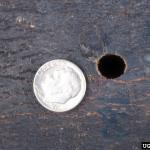
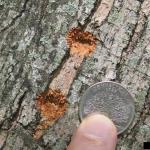 Asian Longhorned Beetle: (Anoplophora glabripennis, ALB) is a serious invasive insect that was first detected in Massachusetts in August of 2008. ALB was detected for the first time in South Carolina in 2020. Asian longhorned beetle eradication programs currently exist in Massachusetts, New York, and Ohio. A homeowner is responsible for finding, reporting, and making officials aware of the infestation in South Carolina. Great job!
Asian Longhorned Beetle: (Anoplophora glabripennis, ALB) is a serious invasive insect that was first detected in Massachusetts in August of 2008. ALB was detected for the first time in South Carolina in 2020. Asian longhorned beetle eradication programs currently exist in Massachusetts, New York, and Ohio. A homeowner is responsible for finding, reporting, and making officials aware of the infestation in South Carolina. Great job!
The U.S. Department of Agriculture’s (USDA) Animal and Plant Health Inspection Service (APHIS) and the Clemson University’s Department of Plant Industry (DPI) are inspecting trees in Hollywood, South Carolina following the detection and identification of the Asian longhorned beetle (ALB).
On May 29, a homeowner in Hollywood, South Carolina contacted DPI to report they found a dead beetle on their property and suspected it was ALB. A DPI employee collected the insect the same day and conducted a preliminary survey of the trees on the property. Clemson’s Plant and Pest Diagnostic Clinic provided an initial identification of ALB, and on June 4, APHIS’ National Identification Services confirmed the insect. On June 11, APHIS and DPI inspectors confirmed that one tree on the property is infested, and a second infested tree was found on an adjacent property. For more information, visit: https://www.aphis.usda.gov/aphis/newsroom/stakeholder-info/sa_by_date/sa-2020/sa-06/alb-sc . A recently released “Draft Environmental Assessment for the Asian Longhorned Beetle Eradication Program in Charleston, Dorchester, and Colleton Counties in South Carolina” from the USDA-APHIS provides a map of the currently known infested trees in that location. The USDA also seeks public comment and review of the Draft Environmental Assessment by September 18, 2020. For more information, visit:https://www.aphis.usda.gov/aphis/newsroom/federal-register-posts/sa_by_date/sa-2020/alb-draft-ea .
This is a good reminder for us to remain vigilant, and report any suspicious beetles or damage to trees, especially maples. Asian longhorned beetle infests 12 genera of trees, however maples are preferred hosts.
Look for signs of an ALB infestation which include perfectly round exit holes (about the size of a dime), shallow oval or round scars in the bark where a female has chewed an egg site, or sawdust-like frass (excrement) on the ground nearby host trees or caught in between branches. Be advised that other, native insects may create perfectly round exit holes or sawdust-like frass, which can be confused with signs of ALB activity.
The regulated area for Asian longhorned beetle is 110 miles2 encompassing Worcester, Shrewsbury, Boylston, West Boylston, and parts of Holden and Auburn. If you believe you have seen damage caused by this insect, such as exit holes or egg sites, on susceptible host trees like maple, please call the Asian Longhorned Beetle Eradication Program office in Worcester, MA at 508-852-8090 or toll free at 1-866-702-9938.
To report an Asian longhorned beetle find online or compare it to common insect look-alikes, visit: http://massnrc.org/pests/albreport.aspx or https://www.aphis.usda.gov/pests-diseases/alb/report .
More information can be found in the “Trouble Maker of the Month” section of July’s edition of Hort Notes:https://ag.umass.edu/landscape/newsletters/hort-notes/hort-notes-2020-vol-315
- Azalea Sawflies: One species of azalea sawfly, Arge clavicornis, is found as an adult in July and lays its eggs in leaf edges in rows. Larvae are present in August and September. Remember, sawfly caterpillars have at least enough abdominal prolegs to spell “sawfly” (so 6 or more prolegs). Bacillus thuringiensis Kurstaki does not manage sawflies.
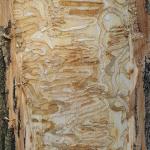
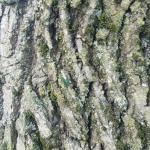
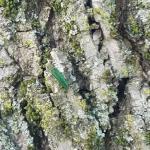 Emerald Ash Borer: (Agrilus planipennis, EAB) As of July 27, 2020, the Massachusetts Department of Conservation and Recreation has confirmed a total of at least 127 communities in Massachusetts that have known populations of emerald ash borer. An updated map of these locations across the state may be found here: https://ag.umass.edu/fact-sheets/emerald-ash-borer .
Emerald Ash Borer: (Agrilus planipennis, EAB) As of July 27, 2020, the Massachusetts Department of Conservation and Recreation has confirmed a total of at least 127 communities in Massachusetts that have known populations of emerald ash borer. An updated map of these locations across the state may be found here: https://ag.umass.edu/fact-sheets/emerald-ash-borer .
This wood-boring beetle readily attacks ash (Fraxinus spp.) including white, green, and black ash and has also been found developing in white fringe tree (Chionanthus virginicus) and has been reported in cultivated olive (Olea europaea). Adult insects of this species will not be present at this time of year. Signs of an EAB infested tree may include (at this time) D-shaped exit holes in the bark (from adult emergence in previous years), “blonding” or lighter coloration of the ash bark from woodpecker feeding (chipping away of the bark as they search for larvae beneath), and serpentine galleries visible through splits in the bark, from larval feeding beneath. Positive identification of an EAB-infested tree may not be possible with these signs individually on their own.
For further information about this insect, please visit: https://ag.umass.edu/fact-sheets/emerald-ash-borer . If you believe you have located EAB-infested ash trees, particularly in an area of Massachusetts not identified on the map provided, please report here: http://massnrc.org/pests/pestreports.htm .
- Fall Home-Invading Insects: Various insects, such as ladybugs, boxelder bugs, seedbugs, and stink bugs will begin to seek overwintering shelters in warm places, such as homes, throughout the next couple of months. While such invaders do not cause any measurable structural damage, they can become a nuisance especially when they are present in large numbers. While the invasion has not yet begun, if you are not willing to share your home with such insects, now should be the time to repair torn window screens, repair gaps around windows and doors, and sure up any other gaps through which they might enter the home.
- Hickory Tussock Moth: Lophocampa caryae is native to southern Canada and the northeastern United States. There is one generation per year. Overwintering occurs as a pupa inside a fuzzy, oval shaped cocoon. Adult moths emerge approximately in May and their presence can continue into July. Females will lay clusters of 100+ eggs together on the underside of leaves. Females of this species can fly, however they have been called weak fliers due to their large size. When first hatched from their eggs, the young caterpillars will feed gregariously in a group, eventually dispersing and heading out on their own to forage. Caterpillar maturity can take up to three months and color changes occur during this time. These caterpillars are essentially white with some black markings and a black head capsule. They are very hairy, and should not be handled with bare hands as many can have skin irritation or rashes (dermatitis) as a result of interacting with hickory tussock moth hairs. By late September, the caterpillars will create their oval, fuzzy cocoons hidden in the leaf litter where they will again overwinter. Hosts whose leaves are fed upon by these caterpillars include but are not limited to hickory, walnut, butternut, linden, apple, basswood, birch, elm, black locust, and aspen. Maple and oak have also been reportedly fed upon by this insect. Several wasp species are parasitoids of hickory tussock moth caterpillars.
- Lacebugs: Stephanitis spp. lacebugs such as S. pyriodes can cause severe injury to azalea foliage. S. rhododendri can be common on rhododendron and mountain laurel. S. takeyai has been found developing on Japanese andromeda, leucothoe, styrax, and willow. Stephanitis spp. lace bug activity should be monitored through September. Before populations become too large, treat with a summer rate horticultural oil spray as needed. Be sure to target the undersides of the foliage in order to get proper coverage of the insects. Certain azalea and andromeda cultivars may be less preferred by lace bugs.
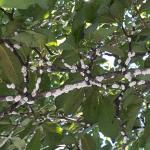
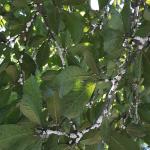 Magnolia and Tuliptree Scales: The soft scale insects known as the magnolia scale (Neolecanium cornuparvum) and the tuliptree scale (Toumeyella liriodendri) can be difficult to differentiate in the field, depending upon the host they are found on. (On Magnolia, it is very difficult to distinguish between the two species of soft scale.) As two native scale insects in North America, the magnolia and tuliptree scales are hosts themselves for natural enemies that can impact their populations. Solitary parasitoid larvae have been collected from Magnolia scales and have been identified as a syrphid fly species, Ocyptamus costatus. The natural enemies of the tuliptree scale have been studied to a greater degree and include certain lady beetle species [Hyperaspis signata, Adalia (formerly Hyperaspis) bipunctata, and Chilocorus stigma] which feed on nymphal scales, a number of parasitic wasps, and even an insect feeding moth caterpillar (Laetilia coccidivora). This particular moth species, also referred to as a type of snout moth, will consume the tuliptree scale underneath the protection of a silken web it spins over them! (The specific epithet coccidivora can be translated as “ones that eat soft scales” or Coccidae.) Unfortunately, in a landscape setting, it often seems that although these natural enemies may be common within the scale populations, they are seldom able to reduce the scale insect numbers below damaging levels. That being said, our management options should still seek to preserve these natural enemies.
Magnolia and Tuliptree Scales: The soft scale insects known as the magnolia scale (Neolecanium cornuparvum) and the tuliptree scale (Toumeyella liriodendri) can be difficult to differentiate in the field, depending upon the host they are found on. (On Magnolia, it is very difficult to distinguish between the two species of soft scale.) As two native scale insects in North America, the magnolia and tuliptree scales are hosts themselves for natural enemies that can impact their populations. Solitary parasitoid larvae have been collected from Magnolia scales and have been identified as a syrphid fly species, Ocyptamus costatus. The natural enemies of the tuliptree scale have been studied to a greater degree and include certain lady beetle species [Hyperaspis signata, Adalia (formerly Hyperaspis) bipunctata, and Chilocorus stigma] which feed on nymphal scales, a number of parasitic wasps, and even an insect feeding moth caterpillar (Laetilia coccidivora). This particular moth species, also referred to as a type of snout moth, will consume the tuliptree scale underneath the protection of a silken web it spins over them! (The specific epithet coccidivora can be translated as “ones that eat soft scales” or Coccidae.) Unfortunately, in a landscape setting, it often seems that although these natural enemies may be common within the scale populations, they are seldom able to reduce the scale insect numbers below damaging levels. That being said, our management options should still seek to preserve these natural enemies.
The magnolia scale is distributed throughout the eastern United States. The tuliptree scale is found east of the Mississippi River from Michigan to Alabama and from New York and Connecticut to Florida. It is also reported to be found in ornamental tuliptrees and magnolias in California and could be found wherever these trees are grown. Magnolia scale host plants include: Magnolia stellata (star Magnolia), M. acuminata (cucumber Magnolia), M. lilliflora ‘Nigra’ (lily Magnolia; formerly M. quinquepeta), and M. soulangeana (Chinese Magnolia). Other species may be hosts for this scale, but attacked to a lesser degree. M. grandiflora (southern Magnolia) may be such an example. Tuliptree scale host plants include: Liriodendron tulipifera (tuliptree or yellow poplar), Magnolia stellata (star Magnolia), and M. soulangeana (Chinese Magnolia). This insect has also been recorded on M. grandiflora (southern Magnolia) and Tilia spp. (linden). The tuliptree scale has also, to a lesser extent, been reported on other ornamental trees and shrubs.
Mature individuals settle on a location on branches and twigs, then insert piercing-sucking mouthparts to feed. The insects feed on plant fluids and excrete large amounts of a sugary substance known as honeydew. Sooty mold, often black in color, will then grow on the honeydew that has coated branches and leaves. Repeated, heavy infestations can result in branch dieback and at times, death of the plant. Honeydew may also be very attractive to ants, wasps, and hornets. The life cycle of both of these species is similar and may have similar timing during the year, however subtle differences exist. The life cycle of the magnolia scale is as follows: This scale overwinters as a young nymph (immature stage) which is elliptical in shape, mostly a dark-slate gray, except for a median ridge that is red/brown in color. These overwintering nymphs may be found on the undersides of 1st and 2nd year old twigs. The first molt (shedding of the exoskeleton to allow growth) can occur by late April or May in parts of this insect’s range and the second molt will occur in early June. At that time, the immature scales have turned a deep purple color. Stems of the host plant may appear purple in color and thickened – but this is a coating of nymphal Magnolia scales, not the stem itself. Eventually, these immature scales secrete a white layer of wax over their bodies, looking as if they have been rolled in powdered sugar. By August, the adult female scale is fully developed, elliptical and convex in shape and ranging from a pinkish-orange to a dark brown color. Adult females may also be covered in a white, waxy coating. By that time, the females produce nymphs (living young; eggs are not “laid”) that wander the host before settling on the newest twigs to overwinter. In the Northeastern United States, this scale insect has a single generation per year.
The lifecycle of the tuliptree scale is as follows: The mature female tuliptree scale is hemispherical in shape. The color of the mature female varies in this species as well - a grayish-green to pink-orange insect mottled with black. Adult males emerge sometime in June and mate with the females. Like the Magnolia scale, eggs develop within the body of the female tuliptree scale, leading to the “live birth” of immatures (crawlers) in late August and September. In the Northeast, one generation of tuliptree scales occurs per year. (However, in the southern-most portions of its range, this insect has been found in all stages of development during the winter, suggesting multiple generations per year.) A single female tuliptree scale may produce 3,000+ crawlers in one season. These crawlers are tiny (approximately the size of the head of a pin) and settle on host plant twigs in September. Past studies have shown that in addition to moving on their own with fully functional legs, the crawlers can be blown to new hosts on the wind, up to 100 feet away. (Being wind-blown to a new host, however, is a haphazard method of travel through which some less than 20% of these crawlers successfully make contact with a host plant, and fewer still attach to a suitable site on the plant.) The immature, crawler stage molts once prior to overwintering.
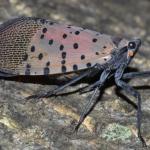 Spotted Lanternfly: (Lycorma delicatula, SLF) is not known to occur in Massachusetts landscapes (no established populations are known in MA at this time). However, due to the great ability of this insect to hitchhike using human-aided movement, it is important that we remain vigilant in Massachusetts and report any suspicious findings. Spotted lanternfly reports can be sent here:https://massnrc.org/pests/slfreport.aspx
Spotted Lanternfly: (Lycorma delicatula, SLF) is not known to occur in Massachusetts landscapes (no established populations are known in MA at this time). However, due to the great ability of this insect to hitchhike using human-aided movement, it is important that we remain vigilant in Massachusetts and report any suspicious findings. Spotted lanternfly reports can be sent here:https://massnrc.org/pests/slfreport.aspx
For a map of known, established populations of SLF as well as detections outside of these areas where individual finds of spotted lanternfly have occurred (but no infestations are present), visit: https://nysipm.cornell.edu/environment/invasive-species-exotic-pests/spotted-lanternfly/ This map depicts an individual find of spotted lanternfly at a private residence in Boston, MA that was reported by the MA Department of Agricultural Resources on February 21, 2019. More information about this detection in Boston, where no established infestation was found, is provided here: https://www.mass.gov/news/state-agricultural-officials-urge-residents-to-check-plants-for-spotted-lanternfly
This insect is a member of the Order Hemiptera (true bugs, cicadas, hoppers, aphids, and others) and the Family Fulgoridae, also known as planthoppers. The spotted lanternfly is a non-native species first detected in the United States in Berks County, Pennsylvania and confirmed on September 22, 2014.
The spotted lanternfly is considered native to China, India, and Vietnam. It has been introduced as a non-native insect to South Korea and Japan, prior to its detection in the United States. In South Korea, it is considered invasive and a pest of grapes and peaches. The spotted lanternfly has been reported from over 70 species of plants, including the following: tree of heaven (Ailanthus altissima) (preferred host), apple (Malus spp.), plum, cherry, peach, apricot (Prunus spp.), grape (Vitis spp.), pine (Pinus spp.), pignut hickory (Carya glabra), sassafras (Sassafras albidum), serviceberry (Amelanchier spp.), slippery elm (Ulmus rubra), tulip poplar (Liriodendron tulipifera), white ash (Fraxinus americana), willow (Salix spp.), American beech (Fagus grandifolia), American linden (Tilia americana), American sycamore (Platanus occidentalis), big-toothed aspen (Populus grandidentata), black birch (Betula lenta), black cherry (Prunus serotina), black gum (Nyssa sylvatica), black walnut (Juglans nigra), dogwood (Cornus spp.), Japanese snowbell (Styrax japonicus), maple (Acer spp.), oak (Quercus spp.), and paper birch (Betula papyrifera).
The adults and immatures of this species damage host plants by feeding on sap from stems, leaves, and the trunks of trees. In the springtime in Pennsylvania (late April - mid-May) nymphs (immatures) are found on smaller plants and vines and new growth of trees and shrubs. Third and fourth instar nymphs migrate to the tree of heaven and are observed feeding on trunks and branches. Trees may be found with sap weeping from the wounds caused by the insect’s feeding. The sugary secretions (excrement) created by this insect may coat the host plant, later leading to the growth of sooty mold. Insects such as wasps, hornets, bees, and ants may also be attracted to the sugary waste created by the lanternflies, or sap weeping from open wounds in the host plant. Host plants have been described as giving off a fermented odor when this insect is present.
Adults are present by the middle of July in Pennsylvania and begin laying eggs by late September and continue laying eggs through late November and even early December in that state. Adults may be found on the trunks of trees such as the tree of heaven or other host plants growing in close proximity to them. Egg masses of this insect are gray in color and look similar in some ways to gypsy moth egg masses.
Host plants, bricks, stone, lawn furniture, recreational vehicles, and other smooth surfaces can be inspected for egg masses. Egg masses laid on outdoor residential items such as those listed above may pose the greatest threat for spreading this insect via human aided movement.
For more information about the spotted lanternfly, visit this fact sheet: https://ag.umass.edu/landscape/fact-sheets/spotted-lanternfly .
- Viburnum Leaf Beetle: Pyrrhalta viburni is a beetle in the family Chrysomelidae that is native to Europe, but was found in Massachusetts in 2004. At this time, adult viburnum leaf beetles can be found mating, feeding, and laying eggs. Females will lay their eggs in pits they chew at the ends of twigs. Eggs overwinter. Adults may also migrate to previously not yet infested plants. This beetle feeds exclusively on many different species of viburnum, which includes, but is not limited to, susceptible plants such as V. dentatum, V. nudum, V. opulus, V. propinquum, and V. rafinesquianum. Some viburnum have been observed to have varying levels of resistance to this insect, including but not limited to V. bodnantense, V. carlesii, V. davidii, V. plicatum, V. rhytidophyllum, V. setigerum, and V. sieboldii. More information about viburnum leaf beetle may be found at http://www.hort.cornell.edu/vlb/ .
Concerned that you may have found an invasive insect or suspicious damage caused by one? Need to report a pest sighting? If so, please visit the Massachusetts Introduced Pests Outreach Project: http://massnrc.org/pests/pestreports.htm .
A note about Tick Awareness: deer ticks (Ixodes scapularis), the American dog tick (Dermacentor variabilis), and the lone star tick (Amblyomma americanum) are all found throughout Massachusetts. Each can carry their own complement of diseases. Anyone working in tick habitats (wood-line areas, forested areas, and landscaped areas with ground cover) should check themselves regularly for ticks while practicing preventative measures. Have a tick and need it tested? Visit the web page of the UMass Laboratory of Medical Zoology (https://www.tickreport.com/ ) and click on the blue Order a TickReport button for more information.
Reported by Tawny Simisky, Extension Entomologist, UMass Extension Landscape, Nursery, & Urban Forestry Program
Weeds
Japanese knotweed is beginning to flower and now is the time to manage this invasive plant. Use a 2% spray solution of glyphosate sprayed to the initiation of spray drip. Do not use herbicide formulations that contain diquat (RewardTM) or tank-mix pelargonic acid (ScytheTM) with the glyphosate. Diquat and pelargonic acid are contact herbicides and have the potential to decrease the efficacy of glyphosate. In areas near water, a formulation of glyphosate that is labeled for these areas should be used. Non-chemical products containing clove oil, citric acid, acetic acid or orange extract will not effectively control Japanese knotweed.
Poison ivy can be treated during the month of September. Glyphosate or triclopyr are the best herbicides for poison ivy control. Triclopyr products should be selected over glyphosate products in areas were grasses need to be saved. Contact (ScytheTM, RewardTM) or the non-chemical/organic herbicide products will provide “burndown” activity only and will not adequately control poison ivy.
At this point in the season, summer annual weeds have become large. Many weeds have become very large and just spraying them will result in unsightly dead vegetation, so hand weeding may be necessary. However, spot spraying with a non-selective herbicide is usually a better strategy than hand-weeding because it does not break the mulch barrier. A determination on a site-by-site basis will need to be made.
Many winter annual weeds will be germinating soon, so now is the time to mulch landscape beds or areas that are known to have populations of winter annual weeds. Compost is not recommended as a mulching material. Some common landscape winter annual weeds are:
mouse-ear cress Arabidopsis thaliana
thymeleaf sandwort Arenaria serpyllifolia
downy brome Bromus tectorum
shepherd's-purse Capsella bursa-pastoris
bittercress Cardamine hirsuta
sticky chickweed Cerastium viscosum
horseweed Conyza canadensis
spring whitlowgrass Draba verna
henbit Lamium amplexicaule
red deadnettle Lamium purpureum
field pepperweed Lepidium campestre
Virginia pepperweed Lepidium virginicum
pineappleweed Matricaria matricariodes
annual bluegrass Poa annua
knawel Scleranthus annuus
common chickweed Stellaria media
field pennycress Thlaspi arvense
corn speedwell Veronica arvensis
purslane speedwell Veronica peregrina
Report by Randy Prostak, Weed Specialist, UMass Extension Landscape, Nursery and Urban Forestry Program
Landscape Practices
With practically all of Massachusetts in "Severe Drought", "Moderate Drought" or "Abnormally Dry" as of 9/1/20, according to the US Drought Monitor (https://droughtmonitor.unl.edu/CurrentMap/StateDroughtMonitor.aspx?MA), it is important to irrigate as efficiently as possible. The following tips will help ensure that irrigation applications are as beneficial as possible.
1. Be aware of, and follow, your local town or municipality water regulations. https://www.mass.gov/doc/water-use-restrictions-map/download
2. Don’t irrigate midday. Evaporation is greatest midday, which could mean that much of the water being applied is lost before it reaches plants! Wind also contributes to evaporation and can change irrigation spray patterns. Early morning and evening are the best times to irrigate.
3. Use drip irrigation or soaker hoses when possible. Overhead irrigation frequently results in watering non-plant surfaces and can result in water interception by plant canopies which can reduce the water that reaches the plants’ root systems.
4. Maintain your irrigation system. Check for leaks, broken spray heads, and perform an irrigation system audit to assure uniformity.
5. Use smart technology. Smart controllers can monitor soil moisture and use environmental conditions to adjust irrigation based on water being lost to evapotranspiration (evaporation and transpiration).
6. Water deeply, allowing water to soak into the ground. Irrigating slowly (via drip irrigation or a slow flow) is key to achieving infiltration vs. runoff. Newly installed plants will need more frequent irrigation until established, especially container grown plants that were produced in soilless substrates. Less frequent, deeper irrigation encourages good root growth which will help plants survive water stress.
7. Apply mulch to planting beds and in tree rings 2-4” deep. Keep mulch away from the base of plants and trees. Mulch helps reduce evaporation, insulates plant roots, and can add organic matter to the soil.
8. Raise your mower blade. Longer grass promotes deeper roots and a more drought-resistant lawn.
9. Reduce the competition for water by controlling weeds.
10. Don’t apply fertilizer under drought conditions. High fertilizer concentration can make available water unavailable to plants. Fertilization will also result in increased growth which increases the water demand.
11. Keep in mind that landscapes typically require one inch of water per week (including rainfall). Unsure of what your system or sprinkler is applying? You can use a rain gauge and see how much water is collected in a certain period of time (30 minutes for example). Use multiple rain gauges if possible to understand if you have good uniformity, or make sure the rain gauge is located in an “average area”.
Report by Mandy Bayer, Extension Assistant Professor of Sustainable Landscape Horticulture, UMass Stockbridge School of Agriculture
Additional Resources
Pesticide License Exams - The MA Dept. of Agricultural Resources (MDAR) is holding exams for new exam applicants. Space is still limited; to register, go to: https://www.mass.gov/pesticide-examination-and-licensing.
To receive immediate notification when the next Landscape Message update is posted, join our e-mail list or follow us on Facebook and Twitter.
For a complete listing of upcoming events, see our upcoming educational events https://ag.umass.edu/landscape/upcoming-events
For commercial growers of greenhouse crops and flowers - Check out UMass Extension's Greenhouse Update website
For professional turf managers - Check out Turf Management Updates
For home gardeners and garden retailers - Check out our home lawn and garden resources. UMass Extension also has a Twitter feed that provides timely, daily gardening tips, sunrise and sunset times to home gardeners at twitter.com/UMassGardenClip
Diagnostic Services
The UMass Plant Diagnostic Lab and the Soil & Plant Nutrient Testing Lab are open and taking samples (mail-in only please, walk-in samples cannot be accepted). Allow additional turnaround time as mail delivery and staffing have been altered due to the pandemic.
- Plant disease, insect pest and invasive plant/weed samples: go to https://ag.umass.edu/services/plant-diagnostics-laboratory for more details.
- Routine soil analysis and particle size analysis ONLY (no other types of analyses available at this time): go to https://ag.umass.edu/services/soil-plant-nutrient-testing-laboratory.
UMass Laboratory Diagnoses Landscape and Turf Problems - The UMass Extension Plant Diagnostic Lab is available to serve commercial landscape contractors, turf managers, arborists, nurseries and other green industry professionals. It provides woody plant and turf disease analysis, woody plant and turf insect identification, turfgrass identification, weed identification, and offers a report of pest management strategies that are research based, economically sound and environmentally appropriate for the situation. Accurate diagnosis for a turf or landscape problem can often eliminate or reduce the need for pesticide use. For sampling procedures, detailed submission instructions and a list of fees, see Plant Diagnostic Laboratory
Soil and Plant Nutrient Testing - The University of Massachusetts Soil and Plant Nutrient Testing Laboratory is located on the campus of The University of Massachusetts at Amherst. Testing services are available to all. The function of the Soil and Plant Nutrient Testing Laboratory is to provide test results and recommendations that lead to the wise and economical use of soils and soil amendments. For complete information, visit the UMass Soil and Plant Nutrient Testing Laboratory web site. Alternatively, call the lab at (413) 545-2311.
Ticks are active any time that temperatures are above freezing! Remember to take appropriate precautions when working and playing outdoors, and conduct daily tick checks. UMass tests ticks for the presence of Lyme disease and other disease pathogens. Learn more

